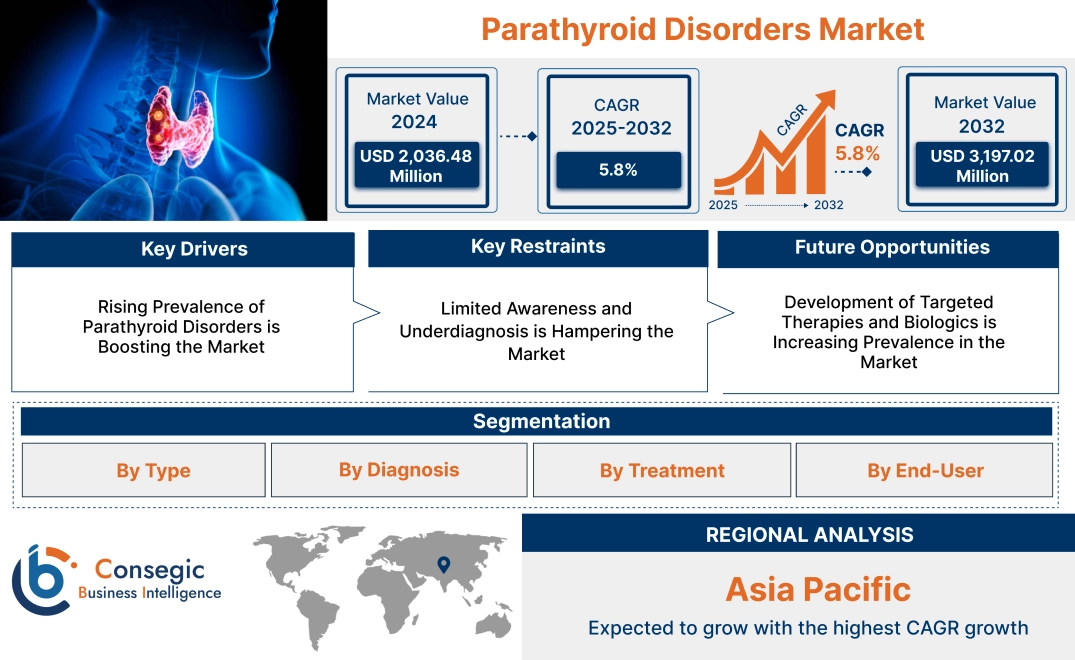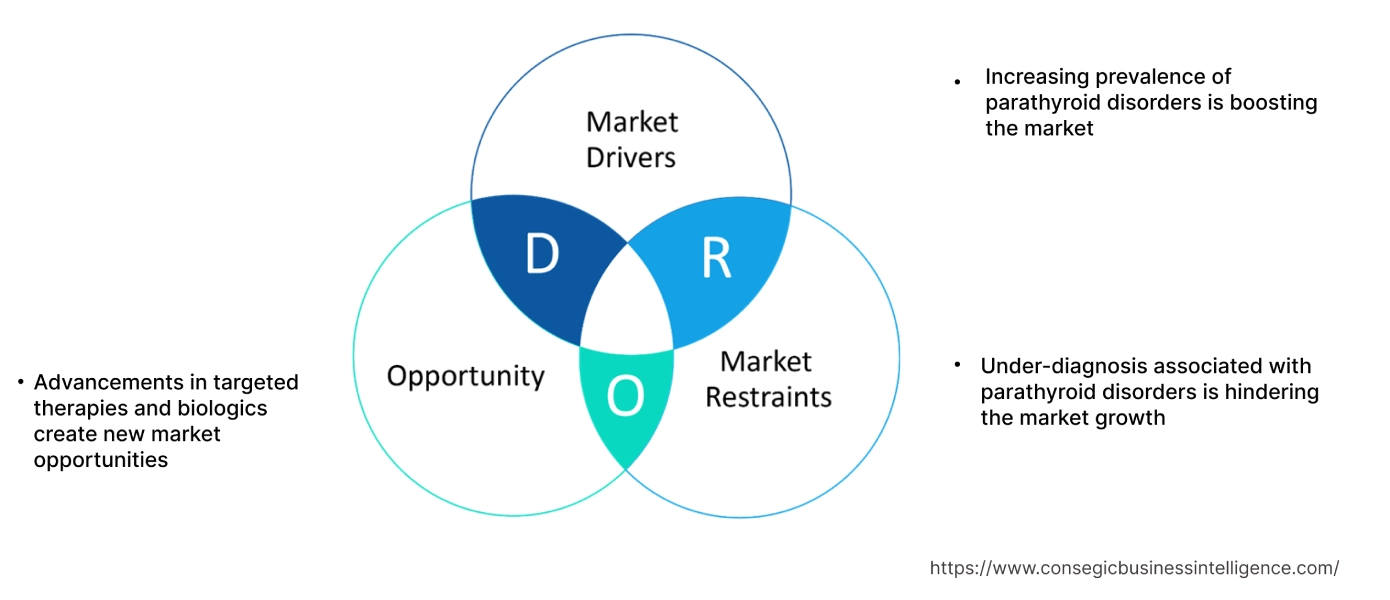- Summary
- Table Of Content
- Methodology
Parathyroid Disorders Market Size:
Parathyroid Disorders Market size is estimated to reach over USD 3,197.02 Million by 2032 from a value of USD 2,036.48 Million in 2024 and is projected to grow by USD 2,118.31 Million in 2025, growing at a CAGR of 5.8% from 2025 to 2032.
Parathyroid Disorders Market Scope & Overview:
The parathyroid disorders require identification, treatment, and management of conditions affecting the parathyroid glands, such as hyperparathyroidism, hypoparathyroidism, and parathyroid cancer. This market includes diagnostic tools like blood calcium and parathyroid hormone (PTH) tests, imaging technologies, surgical interventions, and pharmaceutical therapies such as calcium and vitamin D supplements or PTH analogs. Key characteristics of parathyroid disorder treatments include precision in restoring calcium balance, managing symptoms, and reducing the risk of complications such as osteoporosis and kidney stones. The benefits include improved patient quality of life, reduced recurrence rates, and prevention of long-term complications. Applications span endocrinology clinics, hospitals, and diagnostic laboratories. End-users include endocrinologists, healthcare providers, and patients, driven by increasing awareness of parathyroid conditions, advancements in diagnostic technologies, and the development of targeted therapies for effective management of these disorders.
Key Drivers:
Rising Prevalence of Parathyroid Disorders is Boosting the Market
The increasing prevalence of parathyroid disorders, including hyperparathyroidism and hypoparathyroidism, is a significant driver for the market. Contributing factors such as aging populations, chronic kidney diseases, and widespread vitamin D deficiencies are amplifying the burden of these conditions. Hyperparathyroidism, in particular, is closely associated with postmenopausal women and individuals with prolonged calcium imbalances, emphasizing the need for timely intervention and effective management strategies.
Trends in early detection and proactive healthcare approaches are fostering greater attention to parathyroid health. Analysis indicates that the rising awareness of the systemic complications caused by untreated parathyroid disorders, such as osteoporosis and cardiovascular issues, is further fueling the adoption of advanced diagnostic and therapeutic solutions.
Key Restraints:
Limited Awareness and Underdiagnosis is Hampering the Market
Parathyroid disorders are often underdiagnosed due to their subtle and non-specific symptoms, such as fatigue, muscle weakness, and mood disturbances. This lack of awareness among both patients and healthcare providers delays diagnosis, allowing the disease to progress and result in severe complications. In many cases, primary symptoms are attributed to other conditions, highlighting the challenge of misdiagnosis.
Trends in public health education and specialized training for healthcare providers are attempting to address these gaps, but the current low levels of awareness and diagnostic focus remain significant barriers. Analysis underscores the need for targeted awareness campaigns and improved diagnostic protocols to reduce underdiagnosis and ensure timely treatment.
Future Opportunities :
Development of Targeted Therapies and Biologics is Increasing Prevalence in the Market
Advancements in understanding the molecular and genetic mechanisms underlying parathyroid disorders have opened new avenues for targeted therapies and biologics. These treatments aim to address the root causes of conditions like hypoparathyroidism by regulating calcium levels or replacing deficient hormones, providing a more effective and personalized approach.
Trends in precision medicine are driving the development of innovative biologics, such as recombinant parathyroid hormone analogs, which offer improved therapeutic outcomes with fewer side effects. Analysis highlights that the growing focus on research and development in this area presents significant parathyroid disorders market opportunities for industry players to expand their portfolios and cater to unmet needs in the market.
Parathyroid Disorders Market Segmental Analysis :
By Type:
Based on type, the market is segmented into hyperparathyroidism and hypoparathyroidism. Hyperparathyroidism is further categorized into primary, secondary, and tertiary hyperparathyroidism.
The hyperparathyroidism segment accounted for the largest revenue share in 2024.
- Hyperparathyroidism, particularly primary hyperparathyroidism, is the most prevalent parathyroid disorder globally, driving parathyroid disorders market demand for effective diagnostics and treatment.
- Rising cases of secondary hyperparathyroidism due to chronic kidney disease have significantly contributed to the dominance of this segment.
- Advancements in surgical techniques, such as minimally invasive parathyroidectomy, have improved treatment outcomes for hyperparathyroidism.
- Increased awareness about hyperparathyroidism symptoms and early diagnosis initiatives are further bolstering parathyroid disorders market expansion.
The hypoparathyroidism segment is anticipated to register the fastest CAGR during the forecast period.
- Hypoparathyroidism, although less common, requires long-term management, driving parathyroid disorders market demand for medications and hormone replacement therapies.
- Growing research into recombinant parathyroid hormone therapies is expected to expand treatment options and boost advancement in this segment.
- Increased awareness about hypoparathyroidism's impact on calcium and phosphate balance is driving earlier diagnosis and treatment.
- Rising healthcare access in emerging markets is expected to fuel trends for hypoparathyroidism management solutions.
By Diagnosis:
Based on diagnosis, the market is segmented into blood tests, imaging tests, and bone density tests.
The blood tests segment accounted for the largest revenue in parathyroid disorders market share in 2024.
- Blood tests are the first-line diagnostic tool for parathyroid disorders, assessing calcium, phosphorus, and parathyroid hormone (PTH) levels.
- Their simplicity, cost-effectiveness, and widespread availability have made blood tests the most utilized diagnostic method.
- Rising awareness about the importance of routine calcium and PTH monitoring is supporting trends for blood tests.
- Integration of advanced automated analyzers in laboratories has improved diagnostic accuracy and efficiency.
The imaging tests segment is anticipated to register the fastest CAGR during the forecast period.
- Imaging tests, such as ultrasound and sestamibi scans, are increasingly used for localizing abnormal parathyroid glands, particularly in surgical planning.
- Advances in imaging modalities, including 4D CT scans and MRI, are enhancing diagnostic precision for complex cases.
- The growing prevalence of parathyroid disorders requiring surgical intervention is driving parathyroid disorders market trends for imaging diagnostics.
- Increased adoption of non-invasive imaging techniques in outpatient and ambulatory settings is further supporting segment growth.
By Treatment:
Based on treatment, the market is segmented into medications, surgery, hormone replacement therapy, and dietary management.
The medications segment accounted for the largest revenue in parathyroid disorders market share in 2024.
- Medications, including calcium supplements, vitamin D analogs, and phosphate binders, are widely used to manage symptoms of parathyroid disorders.
- The growing prevalence of hypoparathyroidism requiring long-term medical management has driven demand for therapeutic drugs.
- Development of novel medications targeting secondary hyperparathyroidism in patients with chronic kidney disease is supporting parathyroid disorders market growth.
- Increased focus on patient compliance and advancements in drug formulations, such as extended-release tablets, are bolstering segment trends.
The hormone replacement therapy segment is anticipated to register the fastest CAGR during the forecast period.
- Recombinant parathyroid hormone therapies, such as PTH analogs, are increasingly adopted for treating chronic hypoparathyroidism.
- Rising clinical evidence supporting the efficacy of hormone replacement therapy in improving calcium homeostasis is driving adoption.
- Ongoing research into next-generation hormone therapies and their approval in multiple regions are boosting parathyroid disorders market growth in this segment.
- Increased healthcare access and awareness about advanced therapies in developed and emerging markets are expected to propel advancement.
By End-User:
Based on end-user, the market is segmented into hospitals, specialty clinics, ambulatory surgical centers, and homecare settings.
The hospitals segment accounted for the largest revenue share in parathyroid disorders market of 38.90% in 2024.
- Hospitals remain the primary care centers for diagnosing and treating parathyroid disorders, offering advanced diagnostic and therapeutic options.
- The availability of multidisciplinary teams and specialized surgical units in hospitals supports comprehensive care for complex cases.
- Rising hospital admissions for severe cases of hyperparathyroidism and hypoparathyroidism have driven advancement for hospital-based services.
- Increasing investments in hospital infrastructure and advanced diagnostic technologies are supporting trends in this segment.
The specialty clinics segment is anticipated to register the fastest CAGR during the forecast period.
- Specialty clinics focusing on endocrine disorders are increasingly sought after for personalized care and advanced treatment options.
- The growing prevalence of chronic parathyroid disorders requiring long-term management is driving trends for clinic-based services.
- Expansion of specialty clinics in urban and semi-urban areas, coupled with increasing patient awareness, is boosting advancement.
- Collaboration between specialty clinics and pharmaceutical companies to offer advanced therapies and diagnostic services is expected to propel segment growth.
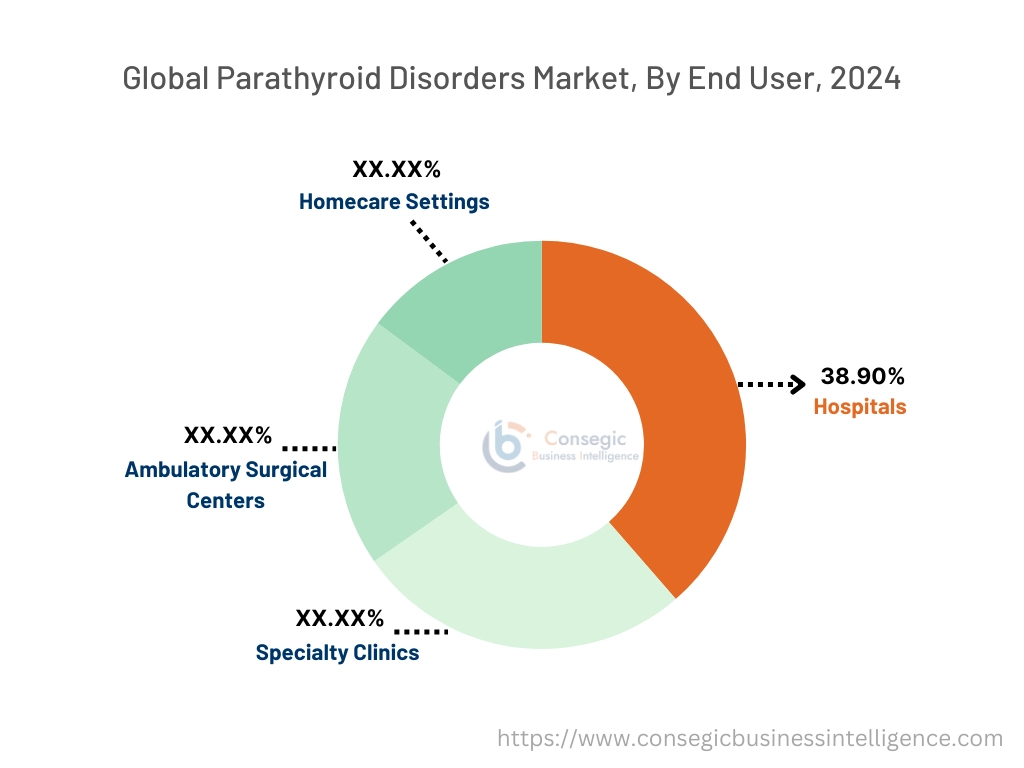
Regional Analysis:
The regions covered are North America, Europe, Asia Pacific, the Middle East and Africa, and Latin America.
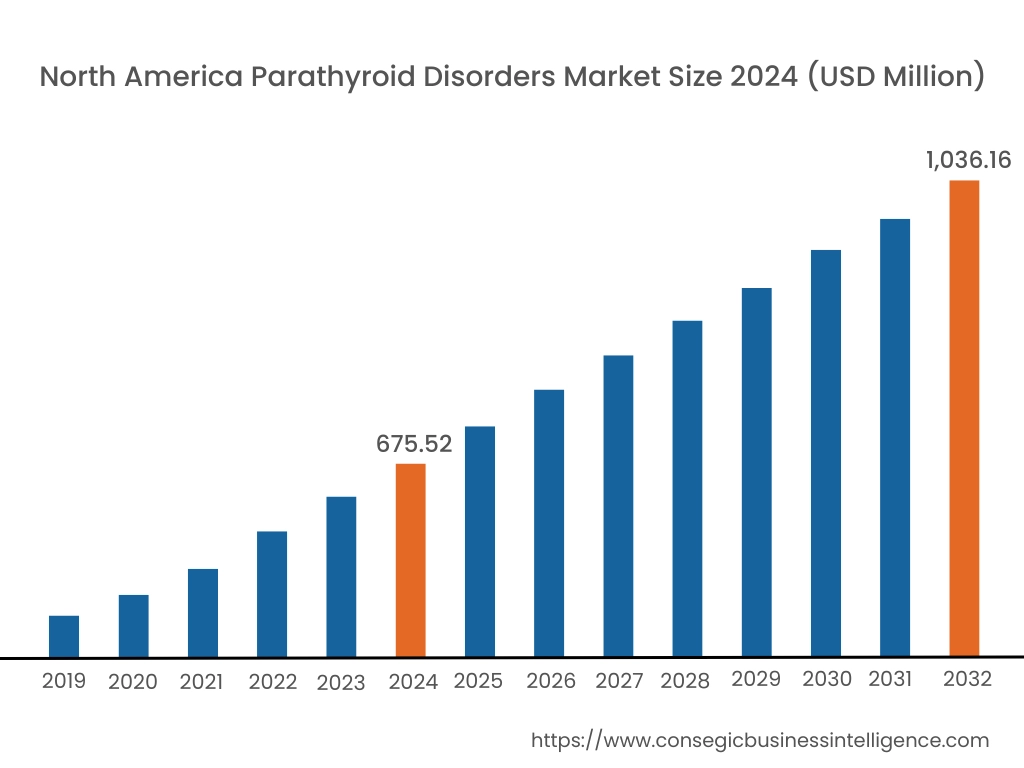
In 2024, North America was valued at USD 675.52 Million and is expected to reach USD 1,036.16 Million in 2032. In North America, the U.S. accounted for the highest share of 74.50% during the base year of 2024. North America holds a significant share in the global parathyroid disorders market, driven by a high prevalence of parathyroid-related conditions such as hyperparathyroidism and hypoparathyroidism. The U.S. leads the region with robust healthcare infrastructure, increasing awareness about endocrine disorders, and widespread availability of advanced diagnostic and therapeutic options. As per the parathyroid disorders market analysis, it shows Canada contributes with rising adoption of minimally invasive surgeries and growing demand for calcium and vitamin D therapies for parathyroid disorders. However, the high cost of treatments and limited access to specialized care in rural areas may pose challenges in the region.
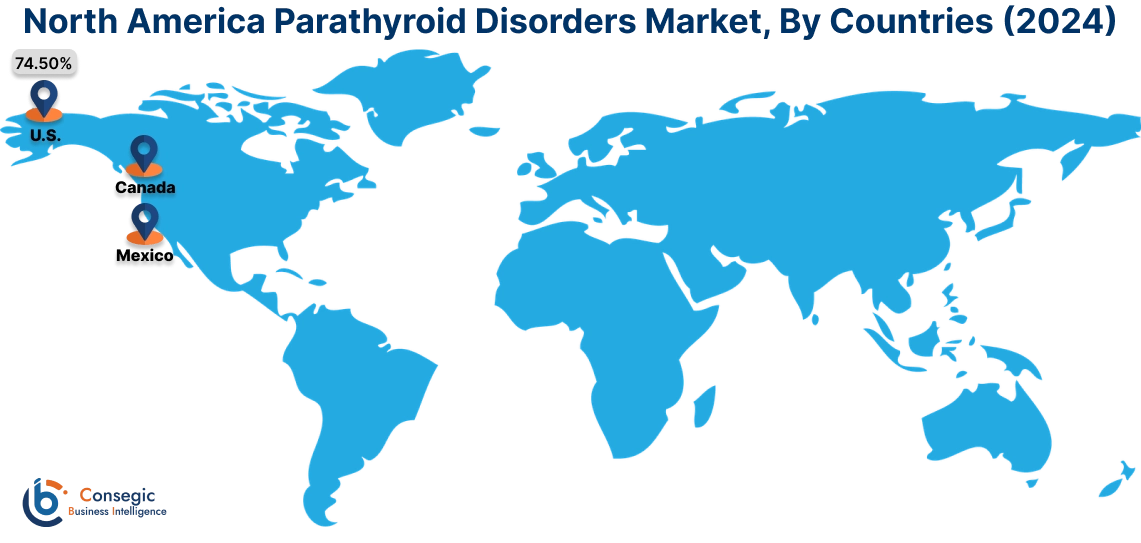
In Asia Pacific, the market is experiencing the fastest growth with a CAGR of 6.2% over the forecast period. The parathyroid disorders market analysis shows it is fueled by increasing awareness of endocrine health, rising healthcare investments, and improving diagnostic capabilities in China, India, and Japan. China dominates the region with growing awareness of parathyroid disorders and rising demand for diagnostic tools and therapies in urban centers. India’s expanding healthcare infrastructure supports the adoption of affordable treatments for parathyroid conditions, especially in calcium and vitamin D supplementation. Japan focuses on advanced diagnostics and precision medicine approaches to manage parathyroid disorders, leveraging its strong medical technology industry. However, limited access to specialized care in rural areas may hinder growth in certain parts of the region.
Europe is a prominent market for parathyroid disorders, supported by increasing prevalence of endocrine disorders, aging populations, and advanced healthcare systems. Countries like Germany, France, and the UK are key contributors. Germany drives demand through its focus on early diagnosis and access to innovative treatments such as parathyroidectomy and hormone replacement therapies. France emphasizes public health programs to raise awareness about the symptoms and risks of parathyroid disorders. The UK focuses on expanding research into novel therapeutics for parathyroid dysfunction. However, budget constraints in public healthcare systems may limit access to advanced treatments in some regions.
The Middle East & Africa region is witnessing steady growth in the parathyroid disorders market, driven by increasing healthcare investments and rising prevalence of endocrine disorders. Countries like Saudi Arabia and the UAE are adopting advanced diagnostic and therapeutic options for parathyroid dysfunction in hospitals and specialty clinics. In Africa, South Africa is emerging as a market, focusing on improving access to care and education about endocrine disorders, particularly in urban areas. However, limited healthcare infrastructure and reliance on imports for advanced diagnostic tools may restrict broader market development in the region.
Latin America is an emerging market for parathyroid disorders, with Brazil and Mexico leading the region. Brazil’s expanding healthcare sector and growing awareness of endocrine health drive parathyroid disorders market trends for diagnostic tools and treatments for parathyroid dysfunction. Mexico emphasizes early diagnosis and treatment of parathyroid disorders through public health initiatives and collaborations with international healthcare organizations. The region is also exploring innovative surgical techniques and hormone replacement therapies. However, economic instability and inconsistent healthcare infrastructure may pose challenges to market growth in smaller economies.
Top Key Players and Market Share Insights:
The parathyroid disorders market is highly competitive with major players providing products to the national and international markets. Key players are adopting several strategies in research and development (R&D), product innovation, and end-user launches to hold a strong position in the parathyroid disorders market. Key players in the parathyroid disorders industry include -
- Amgen Inc. (United States)
- Takeda Pharmaceutical Company Limited (Japan)
- Ascendis Pharma A/S (Denmark)
- Kyowa Kirin Co., Ltd. (Japan)
- Amryt Pharma (Ireland)
- Shire (part of Takeda Pharmaceutical Company) (Ireland)
- Roche Holding AG (Switzerland)
- Sanofi S.A. (France)
- Novartis AG (Switzerland)
- Pfizer Inc. (United States)
Recent Industry Developments :
Approvals:
- In August 2024, Ascendis Pharma received U.S. FDA approval for Yorvipath, a once-daily therapy for adult hypoparathyroidism patients. This approval positions Yorvipath as the sole approved treatment in the U.S. following the discontinuation of Takeda's Natpara at the end of 2024. Clinical studies have demonstrated that most patients treated with Yorvipath do not require daily vitamin D and calcium supplements, which are standard in current care. Ascendis plans to launch Yorvipath in early 2025, with peak sales projected to reach $2.5 billion, indicating a significant advancement in the parathyroid disorders market.
Parathyroid Disorders Market Report Insights :
| Report Attributes | Report Details |
| Study Timeline | 2019-2032 |
| Market Size in 2032 | USD 3,197.02 Million |
| CAGR (2025-2032) | 5.8% |
| By Type |
|
| By Diagnosis |
|
| By Treatment |
|
| By End-Use |
|
| By Region |
|
| Key Players |
|
| North America | U.S. Canada Mexico |
| Europe | U.K. Germany France Spain Italy Russia Benelux Rest of Europe |
| APAC | China South Korea Japan India Australia ASEAN Rest of Asia-Pacific |
| Middle East and Africa | GCC Turkey South Africa Rest of MEA |
| LATAM | Brazil Argentina Chile Rest of LATAM |
| Report Coverage |
|
Key Questions Answered in the Report
What is the projected market size of the Parathyroid Disorders Market by 2032? +
Parathyroid Disorders Market size is estimated to reach over USD 3,197.02 Million by 2032 from a value of USD 2,036.48 Million in 2024 and is projected to grow by USD 2,118.31 Million in 2025, growing at a CAGR of 5.8% from 2025 to 2032.
What are parathyroid disorders? +
Parathyroid disorders include conditions such as hyperparathyroidism, hypoparathyroidism, and parathyroid cancer, which affect the parathyroid glands and disrupt calcium balance in the body.
What are the major drivers for the Parathyroid Disorders Market? +
The rising prevalence of parathyroid disorders, advancements in diagnostic technologies, and increasing awareness about endocrine health are key drivers for the market.
What are the challenges in managing parathyroid disorders? +
Limited awareness, underdiagnosis due to non-specific symptoms, and the high cost of advanced treatments are significant challenges affecting the management of parathyroid disorders.
Which type segment dominates the market? +
The hyperparathyroidism segment dominates the market due to its high prevalence and advancements in surgical treatments, such as minimally invasive parathyroidectomy.
